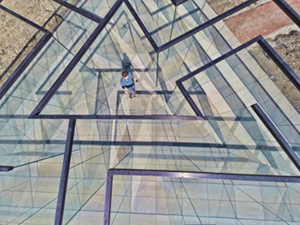
“It is fitting that we begin our celebration of the Donald J. Hall Sculpture Park with this exciting new museum commission that has been made possible through the generosity of the Hall Family Foundation,” said Julián Zugazagoitia, director of the Nelson-Atkins. “Through the years, this oasis of green space has continually evolved as a place of both activity and quiet inspiration in which visitors can enjoy an incredible collection of art. This interactive and contemplative labyrinth sets the stage for an exciting future.”
The installation of Glass Labyrinth begins six months of celebrations of the 22-acre Sculpture Park that will include family activities, educational programs and special events.
“We have lots of fun activities for the whole family planned this summer and fall to celebrate the Sculpture Park,” said Adam Johnson, head of Public Programs. “In July, we partner with Kansas City Parks and Rec to host Kansas City’s Big Picnic. Both the museum and city encourage visitors to embrace this great space as the heart of Kansas City by inviting them to bring a picnic to share with friends and family. There will be food trucks and picnic baskets for purchase, art activities, contests, free Blue Bell ice cream – everything that makes summer, and the Sculpture Park, so special.”
The story of the Sculpture Park began in 1986, when the Hall Family Foundation learned of an extraordinary opportunity. Wichita-based real estate and oil investor George Ablah had decided to sell his extensive collection of sculptures by the English artist Henry Moore. The Foundation purchased 57 works by Moore –monumental sculptures, maquettes and working models, drawings and tapestries. In 1989, 10 bronzes from the former Ablah collection joined Moore’s Sheep Piece (on loan from the City of Kansas City) and Relief No. 1 (from the museum’s collection) in the newly created Henry Moore Sculpture Garden.
The idea of creating an outdoor museum – a place for people of all ages to experience the relationship between art, architecture and nature – was central to the Foundation’s decision to acquire this cache of master works by Moore. It also had been the vision of the original planners of the Nelson-Atkins.
In 1990, the Hall Family Foundation engaged Martin Friedman, director emeritus of the Walker Art Center in Minneapolis and the inspiration and guiding light behind the Minneapolis Sculpture Park, to serve as its art advisor. Friedman’s collaboration with the Nelson-Atkins would continue for 20 years with early signature results like Shuttlecocks by Claes Oldenburg and Coosje van Bruggen and culminating in the commissioning of Roxy Paine’s Ferment.
“Of course, the Shuttlecocks forever changed the landscape and immediately became an integral part of the Sculpture Park and Kansas City when they were installed in 1994,” said Jan Schall, curator of modern art at the museum. “And the Bloch Building itself is a sculptural work of art, with its elegant, light-filled galleries.”
The 2010 installation of Ferment brought crowds of onlookers to the Sculpture Park’s hillside, some bringing picnic lunches as they watched huge steel limbs being hoisted into the air. Today it is one of the most photographed works in the Sculpture Park.
“This is a seminal moment for the Nelson-Atkins,” said Schall. “It’s a time to pause and reflect on this journey we began 25 years ago, and to celebrate everything the Sculpture Park means to the community.”
The clear glass labyrinth is heavier than it appears; the 62-foot by 62-foot by 62-foot, 7-foot-tall labyrinth weighs more than 400 tons. An entire team of community partners provided engineering, construction and installation.
Activities Celebrating 25 Years: The Donald J. Hall Sculpture Park
– Sunday, July 20: Picnic in the Park, 5–8 p.m.
– Thursday, Aug. 7: Teacher Appreciation Night, 4–7 p.m.
– Sunday, Sept. 21: Plains in the Park, Plains Indians Artists of Earth and Sky, noon–4 p.m.
– Saturday, Oct. 11: Bark in the Park, dogs welcome 1–4 p.m.


